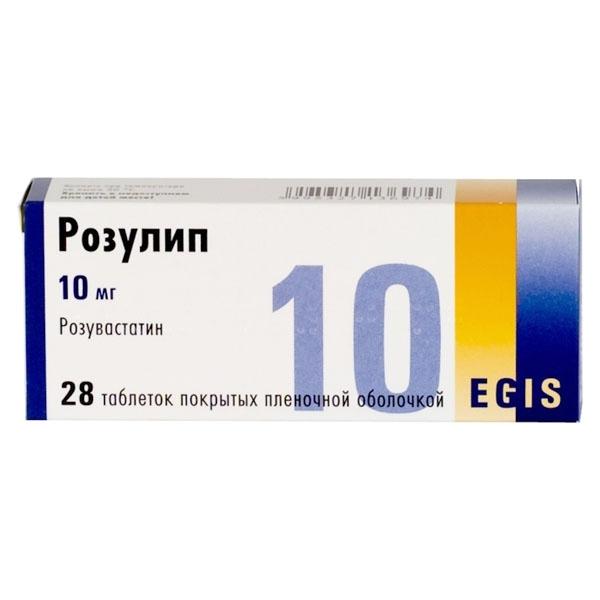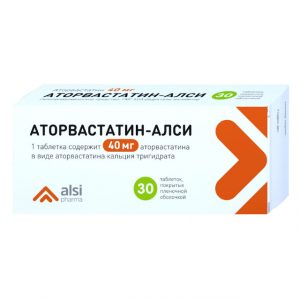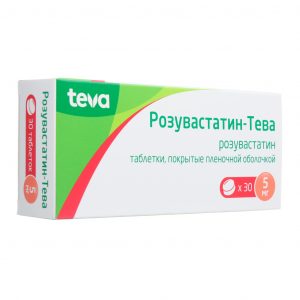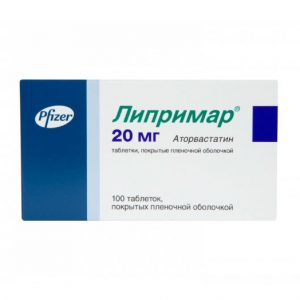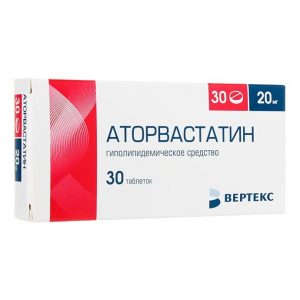Description
Latin name
Rosulip
film release s rdlkp film-coated tablets
packaging 28 pcs
Pharmacological action
Pharmacotherapeutic group: lipid-lowering agent – HMG-CoA reductase inhibitor.
ATX code: C10AA07
PHARMACOLOGICAL PROPERTIES
Mechanism of action
Rosuvastatin is a selective, competitive inhibitor of 3-hydroxy-3-methylglutaryl coenzyme A (HMG-CoA) reductase, an enzyme that converts HM to HM, which converts HM to HM. The main target of the action of rosuvastatin is the liver, where the synthesis of cholesterol and the catabolism of low density lipoproteins (LDL) are carried out.
Rosuvastatin increases the number of liver LDL receptors on the surface of liver cells, increasing the uptake and catabolism of LDL, which in turn leads to inhibition of the synthesis of very low density lipoproteins (VLDL), thereby reducing the total amount of LDL and VLDL.
Pharmacodynamics
Rosuvastatin reduces elevated concentrations of LDL cholesterol, total cholesterol and triglycerides (TG), increases the concentration of high-density cholesterol-lipoproteins (HDL-cholesterol), and also reduces the concentration of apolipoprotein B (Apo B), high-density lipoprotein cholesterol non-HDL), cholesterol-VLDL, TG-VLDLP and increases the concentration of apolipoprotein A-I (Apo A-I) (see tables 1 and 2), reduces the ratio of cholesterol-LDL / cholesterol-HDL, total cholesterol / cholesterol-HDL and cholesterol non-HDL / C-HDL and Apo B / Apo A-I ratio.
The therapeutic effect develops within one week after the start of treatment. In 2 weeks of therapy, the effectiveness reaches a level that is 90% of the maximum possible. The maximum therapeutic effect is usually achieved by the 4th week of therapy and is maintained with regular use of the drug.
Clinical efficacy of
Rosuvastatin is effective in adult patients with hypercholesterolemia with or without hypertriglyceridemia, regardless of race, gender or age, including patients with diabetes mellitus and familial hypercholesterolemia.
In 80% of patients with type IIa and IIb hypercholesterolemia according to the Fredrickson classification (the average initial concentration of LDL-C is about 4.8 mmol / L) when taking the drug at a dose of 10 mg, the concentration of LDL-C reaches less than 3 mmol / L.
In patients with homozygous familial hypercholesterolemia taking rosuvastatin at a dose of 20 mg and 40 mg, the average decrease in LDL-C concentration is 22%.
In patients with hypertriglyceridemia with an initial concentration of TG from 273 to 817 mg / dl, receiving rosuvastatin at a dose of 5 mg to 40 mg once a day for 6 weeks, the concentration of TG in the blood plasma was significantly reduced.
The additive effect is observed in combination with fenofibrate in relation to the concentration of TG and with nicotinic acid in lipid lowering doses in relation to the concentration of HDL-C (see also the section Special Instructions ).
Pharmacokinetics
Absorption and distribution of
The maximum plasma concentration of rosuvastatin (Cmax) is reached approximately 5 hours after ingestion. Absolute bioavailability is approximately 20%.
Rosuvastatin is metabolized primarily by the liver, which is the main site for the synthesis of cholesterol and the metabolism of LDL cholesterol. The volume of distribution (Vd) of rosuvastatin is approximately 134 L. Approximately 90% of rosuvastatin binds to plasma proteins, mostly with albumin.
Metabolism
Undergoes limited metabolism (about 10%). Rosuvastatin is a non-core substrate for metabolism by isoenzymes of the cytochrome P450 system. The main isoenzyme involved in the metabolism of rosuvastatin is the isoenzyme CYP2C9. Isoenzymes CYP2C19, CYP3A4, and CYP2D6 are less involved in metabolism.
The main identified metabolites of rosuvastatin are N-desmethylrosuvastatin and lactone metabolites. N-desmethylrozuvastatin is approximately 50% less active than rosuvastatin, lactone metabolites are pharmacologically inactive. More than 90% of the pharmacological activity in inhibiting circulating HMG-CoA reductase is provided by rosuvastatin, the rest is metabolites.
Excretion of
About 90% of the dose of rosuvastatin is excreted unchanged through the intestines (including absorbed and unabsorbed rosuvastatin). The rest is excreted by the kidneys. The plasma half-life (T1 / 2) is approximately 19 hours. T1 / 2 does not change with increasing dose. The geometric mean plasma clearance is approximately 50 l / h (coefficient of variation 21.7%). As in the case of other HMG-CoA reductase inhibitors, the cholesterol membrane carrier is involved in the process of hepatic uptake of rosuvastatin, which plays an important role in the hepatic elimination of rosuvastatin.
Linearity
Systemic exposure of rosuvastatin increases in proportion to dose. Pharmacokinetic parameters do not change with daily use.
Special patient populations.
Age and gender
Sex and age do not have a clinically significant effect on the pharmacokinetics of rosuvastatin.
Ethnic groups
Pharmacokinetic studies showed an approximately twofold increase in the median area under the concentration-time curve (AUC) and Cmax of rosuvastatin in Asian patients (Japanese, Chinese, Filipinos, Vietnamese and Koreans) compared with Europeans in Indian patients showed an increase in median AUC and Cmax 1.3 times. Pharmacokinetic analysis did not reveal clinically significant differences in pharmacokinetics among Europeans and representatives of the black race.
Renal failure
In patients with mild to moderate renal failure, the plasma concentration of rosuvastatin or N-desmethylrosuvastatin does not change significantly. In patients with severe renal failure (creatinine clearance (CC) <30 ml / min.), The concentration of rosuvastatin in blood plasma is 3 times higher, and the concentration of N-desmethylrosezuvastatin is 9 times higher than in healthy volunteers. The plasma concentration of rosuvastatin in hemodialysis patients was approximately 50% higher than in healthy volunteers. Hepatic insufficiency In patients with various stages of liver failure (with a score of 7 or lower on the Child-Pugh scale), no increase in T1 / 2 of rosuvastatin was detected. Two patients with scores of 8 and 9 on the Child-Pugh scale showed an increase in T1 / 2, at least 2 times. There is no experience with the use of rosuvastatin in patients with a score higher than 9 on the Child-Pugh scale. Genetic polymorphism HMG-CoA reductase inhibitors, including rosuvastatin, bind to the transport proteins OATP1B1 (organic anion transport polypeptide involved in hepatocyte uptake of statins) and BCRP (efflux transporter). Carriers of genotypes SLCO1B1 (OATP1B1) c.521CC and ABCG2 (BCRP) c.421AA showed an increase in exposure (AUC) of rosuvastatin 1.6 and 2.4 times, respectively, compared with carriers of genotypes SLCO1B1 c.521TT and ABCG2 c. 421CC. Indications Primary hypercholesterolemia (type IIa according to the Fredrickson classification) or mixed hypercholesterolemia (type IIb) as a supplement to the diet, when diet and other non-drug therapies (such as exercise, weight loss) are insufficient. Family homozygous hypercholesterolemia as a supplement to diet and other treatment methods aimed at lowering blood lipids (eg, apheresis of LDL), as well as in cases where these methods are not effective enough. Hypertriglyceridemia (type IV according to the classification of Fredrickson) as a supplement to the diet. To slow the progression of atherosclerosis as a supplement to the diet in patients, including those who are shown therapy to reduce the concentration of total cholesterol and LDL-C. Prevention of major cardiovascular complications (stroke, myocardial infarction, arterial revascularization) in adult patients without clinical signs of coronary heart disease (CHD), but with an increased risk of it (older than 50 years for men and older than 60 years for women, increased the concentration of C-reactive protein ( 2 mg / l) in the presence of at least one of the additional risk factors, such as arterial hypertension, low concentration of HDL-C, smoking, family history of early onset of CHD). Contraindications hypersensitivity to rosuvastatin and any of the excipients of liver disease in the active phase, including a persistent increase in serum transaminase activity and any increase in serum transaminase activity (> 3 x upper bounds of normal (VHF)
severe renal impairment (CC <30 ml / min) myopathy concomitant use of cyclosporine in women: pregnancy, the period of breastfeeding, and the lack of adequate methods of contraception in women with Storage reproductive function patients predisposed to the development of myotoxic complications of children under 18 years of age (due to the lack of sufficient clinical data, efficacy and safety have not been established, see the Special Instructions section) lactose intolerance, lactase deficiency or glucose-galactose malabsorption (the drug contains lactose). With caution The presence of a risk of developing myopathy / rhabdomyolysis is renal failure, hypothyroidism, a personal or family history of hereditary muscle diseases and a previous history of muscle toxicity with other HMG-CoA reductase inhibitors or fibrates, excessive alcohol consumption over the age of 65 years of condition in which an increase in the plasma concentration of rosuvastatin is noted racial affiliation (Asian race) simultaneous use with fibrates (see Pharmacokinetics section) history of liver disease, sepsis, arterial hypotension, extensive surgical interventions, injuries, severe metabolic, endocrine or electrolyte disturbances or uncontrolled seizures. Use during pregnancy and lactation Rosulip ® is contraindicated in pregnancy and during breastfeeding. Women of reproductive age should use adequate methods of contraception. If pregnancy is detected during therapy, the drug should be stopped immediately. Since cholesterol and its biosynthesis products are important for fetal development, the potential risk of inhibiting HMG-CoA reductase exceeds the benefits of using the drug in pregnant women. There are no data on the allocation of rosuvastatin with breast milk in humans, therefore, if it is necessary to use the drug, breastfeeding should be discontinued (see section “Contraindications”). Composition Active ingredient: each tablet contains 5 mg, 10 mg, 20 mg or 40 mg of rosuvastatin (in the form, respectively: 5.34 / 10.68 / 21.36 / 42.72 mg of rosuvastatin zinc). Excipients: ludipress 65.16 / 130.32 / 260.64 / 521.28 mg [(lactose monohydrate (93%), povidone (3.5%), crospovidone (3.5%)], crospovidone 3, 75 / 7.50 / 15.00 / 30.00 mg, magnesium stearate 0.75 / 1.50 / 3.00 / 6.00 mg shell: Opadry II white 85F 18422 1.90 / 3.80 / 7, 50 / 15.00 mg [polyvinyl alcohol (40%), titanium dioxide (25%), macrogol 3350 (20.2%), talc (14.8%)]. round biconvex film-coated tablets, white or almost white, with an engraving E on one side of the tablet and number 592 on the other side of the tablet, with or without odor. How to use and dose Inside, do not chew and grind the tablet, swallow the tablet, swallow. The drug can be prescribed at any time of the day, regardless of food intake. Before starting therapy with Rosulip ®, the patient should start to follow a standard hypocholesterolemic diet and continue to follow it during treatment. The dose of the drug should be selected individually depending on the goals of therapy and the therapeutic response to treatment, taking into account current recommendations on target lipid concentration. The recommended starting dose for patients starting to take the drug, or for patients transferred from other HMG-CoA reductase inhibitors, should be 5 or 10 mg of Rosulip ® once a day. When choosing an initial dose, one should be guided by the individual concentration of cholesterol and take into account the possible risk of cardiovascular complications, and it is also necessary to assess the potential risk of side effects. If necessary, the dose can be increased to greater after 4 weeks (see section “Pharmacodynamics”). Due to the possible development of side effects when taking a dose of 40 mg compared to lower doses of the drug (see section Side effects ) increasing the dose to 40 mg after an additional dose above the recommended initial dose for 4 weeks of therapy can be carried out only in patients with severe hypercholesterolemia and a high risk of cardiovascular complications (especially in patients with familial hypercholesterolemia ), for whom the desired result of therapy was not achieved when taking a dose of 20 mg and which will be under the supervision of a specialist (see section “Special Instructions”). Particularly careful monitoring of patients receiving the drug at a dose of 40 mg is recommended. Dosage of 40 mg is not recommended for patients who have not previously consulted a doctor. After 2-4 weeks of therapy and / or with an increase in the dose of Rosulip ®, monitoring of lipid metabolism is necessary (dose adjustment is necessary if necessary). Elderly patients No dose adjustment is required. Patients with renal failure Dose adjustment is not required in patients with mild or moderate renal failure. In patients with severe renal failure (CC <30 ml / min.), The use of Rosulip ® is contraindicated. The use of the drug in a dose of 40 mg is contraindicated in patients with moderate impaired renal function (CC <30-60 ml / min.) (See the section "Special Instructions" and "Pharmacodynamics"). For patients with moderate impaired renal function, an initial dose of 5 mg is recommended. Patients with liver failure Rosulip ® is contraindicated in patients with active liver disease (see the “Contraindications” sections). Special populations Ethnic groups When studying the pharmacokinetic parameters of rosuvastatin in patients belonging to different ethnic groups, an increase in systemic concentration of rosuvastatin among Japanese and Chinese was noted (see the section “Special instructions”). This fact should be taken into account when prescribing Rosulip ® to these patient groups. When prescribing doses of 10 and 20 mg, the recommended initial dose for patients of the Mongoloid race is 5 mg. The administration of the drug in a dose of 40 mg is contraindicated for patients of the Mongoloid race (see section “Contraindications”). Genetic polymorphism In carriers of genotypes SLCO1B1 (OATP1B1) c.521CC and ABCG2 (BCRP) c.421AA, an increase in exposure (AUC) to rosuvastatin was noted compared to carriers of genotypes SLCO1B1 c.521TT and ABCG2 c.421. For patients carrying genotypes c.521CC or c.421AA, the recommended maximum dose of Rosulip ® is 20 mg once a day (see the sections Pharmacokinetics , Special Instructions and Interaction with Other Medicines ). Patients predisposed to myopathy Administration of the drug in a dose of 40 mg is contraindicated in patients with factors that may indicate a predisposition to the development of myopathy (see section “Contraindications”). When prescribing doses of 10 and 20 mg, the recommended initial dose for this group of patients is 5 mg (See section “Contraindications”). Concomitant therapy Rosuvastatin binds to various transport proteins (in particular, OATP1B1 and BCRP). With the combined use of the drug Rosulip ® with drugs (such as cyclosporine, some human immunodeficiency virus (HIV) protease inhibitors, including a combination of ritonavir with atazanavir, lopinavir and / or tipranavir), which increase the concentration of rosuvastatin in plasma due to interaction with transport proteins, may increase the risk of myopathy (including rhabdomyolysis) (see Special instructions “And” Interaction with other drugs “). You should read the instructions for use of these drugs before their appointment with the drug Rosulip ®, assess the possibility of prescribing alternative therapy or temporarily stop taking Rosulip ®. If the use of the above drugs is necessary, it is necessary to assess the ratio of the benefit and risk of concomitant therapy with Rosulip ® and consider the possibility of reducing its dose (see section “Interaction with other drugs”). Side effects Side effects observed when taking Rosulip ® are usually mild and go away on their own. As with other HMG-CoA reductase inhibitors, the incidence of side effects is primarily dose-dependent. The frequency of adverse effects is as follows: often (> 1/100, <1/10) infrequently (> 1/1000, <1/100) rarely (> 1/10000, <1/1000) very rarely (< 1/10000), unspecified frequency (cannot be calculated according to available data). immune system Rarely: hypersensitivity reactions, including angioedema Endocrine system Often: type 2 diabetes mellitus From the central nervous system (CNS) Often: headache, dizziness From the digestive side , nausea, abdominal pain Rarely: pancreatitis From the skin integument Infrequently: itching, skin rash, urticaria From the musculoskeletal system Often: myalgia Rarely: myopathy, rabbit (including myositis) Other Often: asthenic syndrome From the urinary system Proteinuria may be detected in patients treated with rosuvastatin. Changes in the amount of protein in the urine (from the absence or trace amounts to ++ or more) are observed in less than 1% of patients receiving 10 to 20 mg of the drug. A slight change in the amount of protein in the urine was observed when taking a dose of 20 mg. In most cases, proteinuria decreases or disappears during therapy and does not mean the occurrence of acute or progression of an existing kidney disease. From the musculoskeletal system When using rosuvastatin in all doses, and especially when taking doses of the drug in excess of 20 mg, the following effects on the musculoskeletal system were reported: myalgia, myopathy (including myositis), in rare cases, rhabdomyolysis with acute renal failure or without it. A dose-dependent increase in creatine phosphokinase (CPK) activity is observed in a small number of patients taking rosuvastatin. In most cases, it was mild, asymptomatic and temporary. In case of increased activity of CPK (> 5x VGN), therapy should be suspended (see section “Special instructions”).
On the part of the liver
When using rosuvastatin, a dose-dependent increase in the activity of liver transaminases is observed in a small number of patients. In most cases, it is insignificant, asymptomatic and temporary.
Laboratory indicators
When using rosuvastatin, the following changes in laboratory parameters were also observed: an increase in the concentration of glucose, bilirubin, the activity of gamma-glutamyl transpeptidase, alkaline phosphatase, and dysfunction of the thyroid gland.
Post-marketing use of
The following side effects have been reported in the post-marketing use of rosuvastatin:
From the hematopoietic system
Frequency unknown: thrombocytopenia
From the digestive tract
Very rare: jaundice, hepatitis sdlkp
From the musculoskeletal system
Very rare: arthralgia
Frequency unknown: immune-mediated necrotizing myopathy
From the central nervous system
Very rare to: the loss or decline of memory
Frequency unknown: peripheral neuropathy
Respiratory system:
Frequency not known: cough, shortness of breath
From the urinary system
Very rare: hematuria
From the skin and subcutaneous fat
Frequency unknown: Stevens-Johnson syndrome
Reproductive system and breast
Frequency unknown: gynecomastia
Other
Frequency unknown: some peripheral edema
reported :
depression, sleep disturbances, including insomnia and “nightmare” dreams, sexual dysfunction. Isolated cases of interstitial lung disease have been reported, especially with prolonged use of drugs (see section “Special instructions”).
Drug Interaction
Effect of other drugs on rosuvastatin
Transport protein inhibitors: rosuvastatin binds to some transport proteins, in particular OATP1B1 and BCRP. Concomitant use of drugs that are inhibitors of these transport proteins, may be accompanied by an increase in the plasma concentration of rosuvastatin and an increased risk of myopathy (see Table 3 and sections Dosage and administration and Special instructions ).
Cyclosporine: when co-administered with rosuvastatin and cyclosporine, the AUC of rosuvastatin was on average 7 times higher than that observed in healthy volunteers (see Table 3). Does not affect the plasma concentration of cyclosporine. Rosulip ® is contraindicated in patients receiving cyclosporine (see Contraindications).
HIV protease inhibitors: Although the exact mechanism of interaction is unknown, co-administration of HIV protease inhibitors can lead to a significant increase in rosuvastatin exposure (see Table 3). Pharmacokinetic study on the concomitant use of 20 mg rosuvastatin with the combined preparation, containing two HIV protease inhibitors (400 mg lopinavir / 100 mg ritonavir) in healthy volunteers resulted in an approximately two- and fivefold increase in rosuvastatin AUC (0-24) and Cmax, respectively. Therefore, concomitant administration of rosuvastatin and HIV protease inhibitors is not recommended (see section Method of administration and dose , Special instructions , table 3).
Gemfibrozil and other lipid-lowering agents: the combined use of rosuvastatin and gemfibrozil results in a 2-fold increase in the Cmax and AUC of rosuvastatin (see section Special instructions ). Based on the specific interaction data, no pharmacokinetically significant interaction with fenofibrate is expected, a pharmacodynamic interaction is possible.
Gemfibrozil, fenofibrate, other fibrates and lipid-lowering doses of nicotinic acid increased the risk of myopathy when co-administered with HMG-CoA reductase inhibitors, possibly due to the fact that they may cause myopathy when used in monotherapy (see Special Instructions). At simultaneous administration of the drug with gemfibrozil, fibrates, nicotinic acid in lipid-lowering doses (more than 1 g / day), patients are recommended an initial dose of the drug 5 mg, a dose of 40 mg is contraindicated when co-administered with fibrates (see “Contraindications”, ” Method of administration and dosage “,” Special instructions “).
Ezetimibe: concomitant administration of rosuvastatin at 10 mg and ezetimibe at 10 mg was accompanied by an increase in rosuvastatin AUC in patients with hypercholesterolemia (see Table 3). An increased risk of side effects due to the pharmacodynamic interaction between Rosulip ® and ezetimibe cannot be ruled out.
Antacids: the simultaneous administration of rosuvastatin and suspensions of antacids containing magnesium and aluminum hydroxide results in a decrease in the plasma concentration of rosuvastatin by about 50%. This effect is less pronounced if antacids are administered 2 hours after taking rosuvastatin. The clinical significance of such interaction has not been studied.
Erythromycin: concomitant administration of rosuvastatin and erythromycin results in a 20% decrease in rosuvastatin AUC and a rosuvastatin Cmax of 30%. Such interaction may result from increased intestinal motility caused by the intake of erythromycin.
Cytochrome P450 isoenzymes: results from in vivo and in vitro studies showed that rosuvastatin is neither an inhibitor nor an inducer of cytochrome P450 isoenzymes. In addition, rosuvastatin is a weak substrate for these isoenzymes. Therefore, no interaction of rosuvastatin with other drugs at the level of metabolism is expected with the participation of cytochrome P450 isoenzymes. There was no clinically relevant interaction of rosuvastatin with fluconazole (an inhibitor of CYP2C9 and CYP3A4 isoenzymes) and ketoconazole (an inhibitor of CYP2A6 and CYP3A4 isoenzymes).
Fusidic acid: no studies have been performed to study the interaction of rosuvastatin and fusidic acid. As with other statins, post-marketing reports of rhabdomyolysis with rosuvastatin and fusidic acid have been reported. Patients should be closely monitored. If necessary, temporary discontinuation of rosuvastatin.
Interaction with medicinal products requiring dose adjustment of rosuvastatin (see table 3)
The dose of Rosulip ® should be adjusted when necessary when co-administered with medicinal products that increase exposure to rosuvastatin. You should read the instructions for use of these drugs before their appointment with rosuvastatin. If the exposure is expected to increase by 2 times or more, the initial dose of Rosulip ® should be 5 mg once daily. The maximum daily dose of Rosulip ® should also be adjusted so that the expected exposure to rosuvastatin does not exceed that for the 40 mg dose taken without the concomitant administration of rosuvastatin drug. For example, the maximum daily dose of Rosulip ® when co-administered with gemfibrozil is 20 mg (increase in exposure by 1.9 times), with ritonavir / atazanavir – 10 mg (increase in exposure by 3.1 times).
Effect of administration of rosuvastatin on other drugs
Vitamin K antagonists: initiation of rosuvastatin therapy or increasing the drug dose in patients receiving concomitant vitamin K antagonists (eg, warfarin) may lead to an increase in International Normalized Attitude. Withdrawal of rosuvastatin or a decrease in the dose of the drug can lead to a decrease in INR. In such cases, the control of INR is recommended.
Oral contraceptives / hormone replacement therapy: co-administration of rosuvastatin and oral contraceptives increases the ethinyl estradiol AUC and norgestrel AUC by 26% and 34%, respectively. respectively. This increase in plasma concentration should be taken into account when selecting the dose of oral contraceptives. Pharmacokinetic data on the concomitant use of the drug Rosulip ® and hormone replacement therapy are absent, therefore, it is impossible to exclude a similar effect when using this combination. However, this combination was widely used during clinical trials and was well tolerated by patients.
Other medicines: no clinically relevant interaction of rosuvastatin with digoxin is expected.
Overdose
When administered with multiple daily doses, the pharmacokinetic parameters of rosuvastatin do not change.
There is no specific treatment for overdose with rosuvastatin. In case of overdose, it is recommended to carry out symptomatic and supportive therapy, measures, aimed at maintaining the functions of vital organs and systems. Control of liver function and CPF activity is required. The effectiveness of hemodialysis is unlikely.
Storage conditions
Store at a temperature not exceeding 30 ° C. Keep the drug out of the reach of children!
Expiration
2 years.
Active ingredient
ozuvastatyn
Prescription terms from
pharmacies Prescription
dosage form
dosage form
tablets
